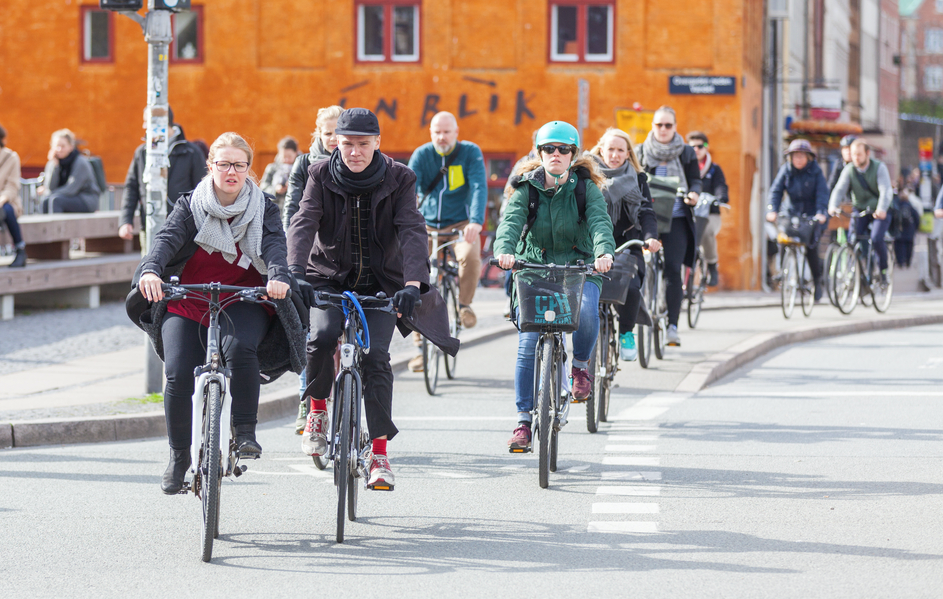Life in the bike lane: what New Zealand can learn from cycle-friendly cities overseas

With Green MP Julie Anne Genter (Minister for Women, Associate Minister Transport and Associate Minister Health) cycling to Auckland City hospital to be induced over the weekend, and the announcement of the SkyPath to be fully funded by the Government, cycling is big news at the moment and, as trips by cycle continue to increase as the infrastructure gets built, we can expect more announcements like this in the future.
While cycling infrastructure has been controversial, with questions raised over the process in Wellington, ongoing complaining from the car-lovers questioning the numbers and Birkenhead locals worried about extra cars (and maybe too much lycra), the trend is clear. So could our cities get to the standard of those seen in Europe? Cycling cultures aren’t born. They’re made. So here’s what we can learn from some of them.
Copenhagen inspires politicians and punters globally, particularly the introduction of the ‘green wave’ in 2007. This is where signals are timed so that cyclists are guaranteed a series of green lights if they maintain a 20 kilometres per hour speed limit, both in the morning commute to work and on the way home.
Other design features in the city are footrests and railings, the idea that good design encourages good behaviour, and how crucial it is for cyclists and citizens to feel safe. And in 2016, for the first time bikes outnumbered cars in the city
The Guardian recently put up a series of graphs – using Copenhagen as the exemplar – to show how bikes have the potential to transform a city.
It’s interesting to find out that Copenhagen wasn’t always like this – proving a city (like Auckland!) just has to start somewhere, weathering experimentation and failures. It took massive grassroots protests – for safer streets and the re-implementation of bicycle infrastructure – in 1970s and 1980s to force urban planners and politicians to return to planning for pedestrians and cyclists.
Amsterdam is another city where bikes are at the forefront of transportation, with bikes having the right of way over cars. Anyone that has been there knows bikes rule and cars drool in the Netherland’s capital, with the young and old all taking part. The city even appointed a ‘bicycle mayor’ in 2016 to help smooth conflict, problems mostly to do with bike-jams during heavy commuter hours and with tourists who are not as savvy as locals on their bikes.
An article in The Guardian in 2015 explained that, similar to Copenhagen, it is only thanks to “fierce activism and a number of decisive events” in the 1970s that Amsterdam started on its path to becoming what has been termed the ‘cycling capital of the world’.
NZTA research suggests that three-quarters of adult urban New Zealanders would cycle if there were safer networks. But cycling infrastructure is not the new normal just yet, the capital-city-of-cars is in the messy middle of bike-lash, budget limits and political and design compromise.
And the whole country is taking part – with one example the suburb of Houten in the city of Utrecht, an entire city built to prioritise cyclists and pedestrians. As of 2015, the Netherlands boasted 22,000 miles of cycle paths, with more than a quarter of all trips are made by bicycle, compared with two percent in the UK. It seems the popularity is only growing with the boom of the electric bike, which allows commuters to travel much further with a similar amount of energy expenditure.
As well as incentivising cycling through infrastructure, many cities also try to disincentivise driving, with London implementing a congestion charge back in 2003 for cars in the central city during working hours (there is also an oft-quoted but erroneous assumption that Amsterdam has a rule where drivers are always at fault if they have an accident involving a bike, but, as the below diagram shows, it’s slightly more complicated than that).

Big cities such as London, Hangzhou, Dublin, Barcelona and Paris have established successful bike share schemes such as Santander cycles or Mobike. These generally work due to the number and price of bikes.
While these have worked really well in some places, there have often been times when it’s gone awry: a scheme in Milton Keynes in the UK in 2016 where half the fleet were trashed within a year, this month a Chinese sharing scheme threatened to pull out of Manchester after bikes were found up lampposts, in waterways or stolen, bikes in rivers in Melbourne and most frighteningly, an oversupply in China which lead to thousands and thousands of abandoned and broken bikes.
In Auckland, Onzo seemed to ask for forgiveness rather than permission when it launched its dockless pay-by-the-hour scheme late last year and, while there have been the usual examples of bikes in trees, in volcanoes and in the water, Onzo said there have been over 100,000 rides so far and it has plans to launch the scheme in other cities around New Zealand, including Wellington and Rotorua.
The Rechargery is another hire scheme, this one focused on ebikes, that launched in Auckland in February this year. The scheme, which is a joint effort between Mercury and Big Street Bikers, aims to ‘hack Auckland’s transport issues’ by boosting e.bike uptake. It offers e.bike recharging, free test rides, longer-term hires and ride-to-own plans to help knock down the barriers to ownership.
According to Statistics NZ approximately 300,000 commuters travel less than 5km to work every day and the average Aucklander spends about 20 days sitting in traffic every year.
“There’s a massive opportunity for individuals to take control of their commute and avoid Auckland’s crippling gridlock while saving money and having a great time doing it,” said co-founder (and self-described lazy man) Matt Weavers. “Each person we help go from four wheels to two kicks the e.bike revolution up another gear … The impact of over 1,000 riders enjoying the freedom of an e.bike whilst harnessing the power of the sun, means a reduction in cars clogging the streets and a whole lot less nasty CO2 emissions being pumped into our city’s atmosphere.”
Ralph Johns, Isthmus’ CEO, recently went on a 140km bike tour across Auckland’s cycleways. And as he said: “Bolstered by an international cycling renaissance, Auckland has started to plan and build for cycling, with investment predicated upon proven returns that riding a bike improves health, environment and the economy. NZTA research suggests that three-quarters of adult urban New Zealanders would cycle if there were safer networks. But cycling infrastructure is not the new normal just yet, the capital-city-of-cars is in the messy middle of bike-lash, budget limits and political and design compromise.”
“Riding a bike engages all the senses. It’s spontaneous, flexible and efficient, and it’s simply the best way to experience the city. And as it turns out, Auckland’s actually a great place to ride a bike. If we keep planning and designing for cycling, connecting the missing links, then filling in the finer grain, Auckland could do the impossible and become one of the world’s great cycling cities. It’ll take another 20 years, but it’ll be worth it.”




